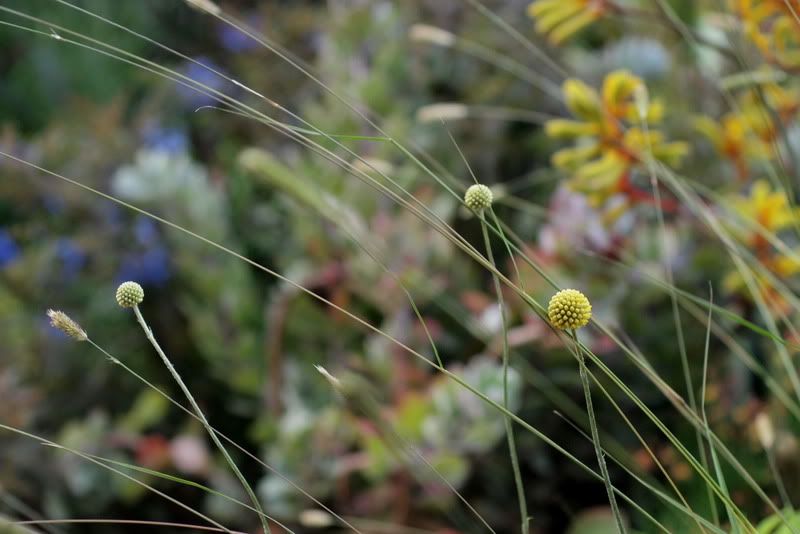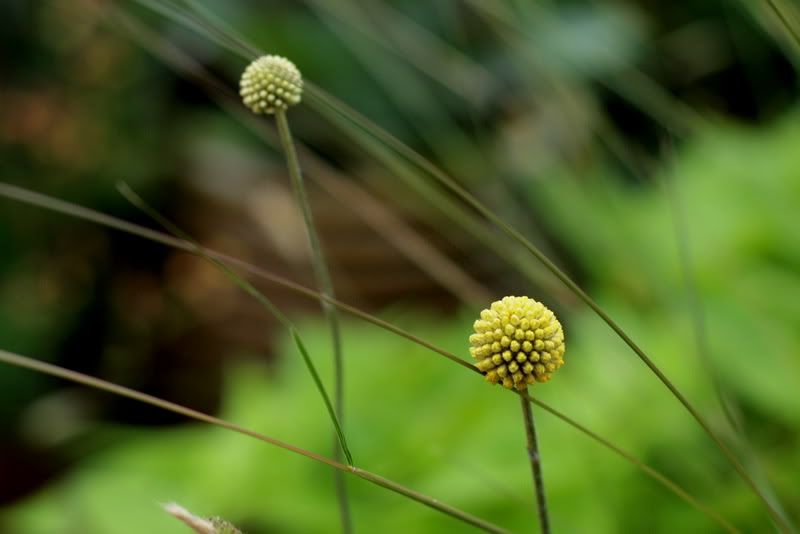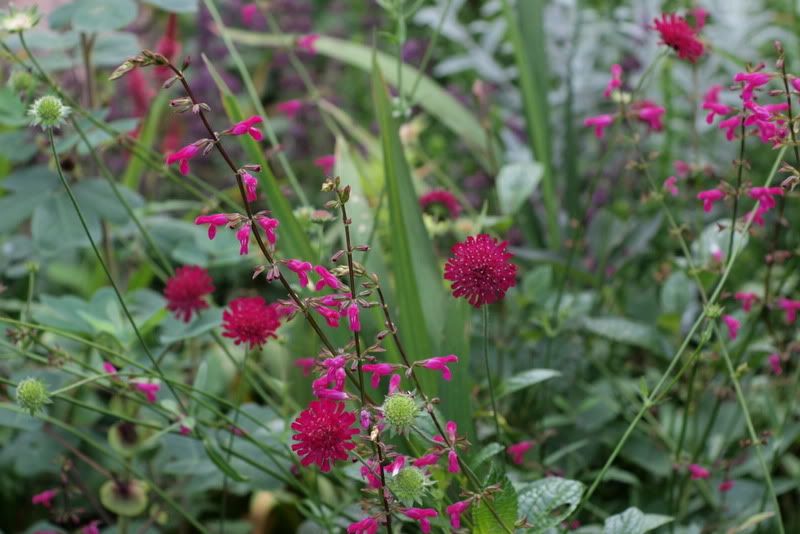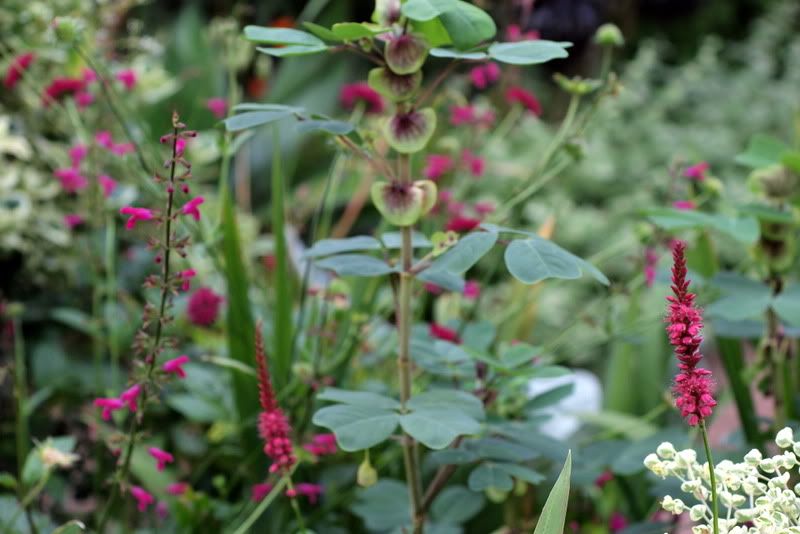Thanks to the late plantsman and artist Kevin Nicolay for this phrase he coined to describe plants that possess elongated fireworks of some kind, whether seed capsule or flower.
I think it originates from an interview with Kevin in Horticulture many years ago.
I suppose it’s possible to carry the idea too far, but if so I wouldn’t know where to draw the line.
Indeed, drawing a line is exactly what aerial fizz plants can be relied upon to do, an elegant line sometimes still and emphatic as a woodcut, sometimes lazily swaying.
Aerial fizz plants animate and slice through unused dimensions of garden space. I’ve come to rely heavily on such plants for my small garden.
I planted three clumps of Pennisetum spathiolatum, the Slender Veldt Grass (to zone 6/7), along the pathway of the back garden that you can’t help but brush against, see, touch, when taking out the trash or feeding the cats on the back porch or chasing the corgi. This would most likely be a terrible idea for a public garden, since I imagine there are some people who don’t wish to be caressed by plants and would be horribly annoyed. At least, I’m pretty sure such people exist.

This grass stays about a foot high but shoots a scrim of flowering missiles to 4 feet. Just behind the grass, the kangaroo paws branch skyward to 5 feet.
All this and more within a few feet of the back door. Lots of verticals. Too hectic?
Personally, I like to get a garden up on its hind legs and just added more extreme verticality over the weekend amongst the grasses.
Verticalicious:

Similar to echinops but in yellow instead of blue, and without the massive girth, Craspedia globosa aka Billy Balls. There’s a name I won’t forget.
Craspedia is always listed as a great dried flower, good for hobbyists. But I saw this plant used in a landscape in San Francisco last year, possibly designed by Beth Mullins, and I’ve been on the lookout for it at nurseries ever since. I found two 4-inch pots this weekend.

From the land Down Under, Australia, as well as New Zealand and Tasmania. Possibly perennial in my zone 10, grown as an annual elsewhere. This is clearly not just a hobbyist’s plant, since it possesses enormous amounts of aerial fizz, as much as any allium, though mustard yellow rather than purple, and grassy, silvery leaves that are nothing to be ashamed of. I like to see these plants spring from the horizontal, as if bursting vigorously through the pavement, not deep in a border. To live this close with plants, they have to possess good leaves that stay neat, if not interesting, for much of the growing season.

Many plants I can’t grow in zone 10, or grow well, possess excellent aerial fizz. Sanguisorbas, thalictrum, astrantia, astilbe. Knautia provides this quality.
(Dierama does as well, but it takes so long to establish I’m still unsure if it will bloom well in zone 10.)
But there is a point when blooms become too large, and we’ve left the realm of aerial fizz and entered another, where round, solid shapes provide heft, not fizz.

Persicaria amplexicaule insinuating blooms into the kangaroo paws. I know, I know, watch the ketchup and mustard. In a small garden, the color clashes come fast and furious.
This knotweed is too good not to grow and provides months of aerial fizz. I’ve tried the white varieties, and they’re just not as vigorous.
(The golden-leaved variety ‘Golden Arrow’ is difficult to site to both flower well and avoid leaf burn but when conditions are met is a gorgeous plant.)

Removing the mustard, in photo if not garden. In small gardens, compromise is inevitable. For me verticality, movement, aerial fizz trumps color every time.


Great post…I’m totally in the same boat…love these plant with their blooms that float in the air. I found some of the Pennisetum at the HPSO plant sale last fall (had never heard of it before…GASP) and was instantly attracted to those wispy little blossoms…on those stems that are practically invisible. I wish I could have bought more, but I considered myself lucky to get the last one! I planted some Knautia ‘Melton Pastels’ from seed this year, again, hoping for that effect…the floating, bobbing blossoms…kept seeing them in garden mags and knew they were a good fit for my garden. I wish the Billy Balls was hardy for us here…oh well. I have a few Persicaria and love them to death…tiny little wands of flowers, but in such profusion! I have P. ‘Lance Corporal’, which has long, wiry stems of flowers…but the flowers are barely visibly, still, the effect of all those stems is kinda magical!
Oh how I long to grow the Craspedia globosa, even as an annual. LOVE IT! I buy them at the cut flower market all the time.
I killed my Billy Balls, or perhaps it just died. I miss that plant!
Thanks for passing on the concept and the term. I love and use “aerial fizz” but I didn’t have a name for it, certainly not a name with such descriptive fun and zip! It’s made a vague notion into a sharp, clear concept.
James, it’s probably because Kevin Nicolay had such a sharp eye as an artist and a gardener that he found the words that so perfectly described these plants.
I remember when we started growing Craspedia globosa when I was at Annie’s Annuals. I googled Billy Balls looking for images we might use on our sign and hoo-boy! I certainly got an eyeful! Anyway, I was wondering what plant that is that is dead center in your last photo? I’ve never seen that before.
Kelly, I guess plant ID can never compete in search hits with the number one use for the Internet. The plant in the middle is Amicia zygomeris, mail-ordered from Plant Delights, planted fall 2010 and started blooming right away. Pea family foliage. I like it a lot.
The Craspedias, yes! they are one of my favorites! Use them with succulents as once they get established, they are like any other drought tolerant plant (in the Bay area). The leaves are so amazing to pick up silvers from nearby olives, leucodendrons or grasses…..